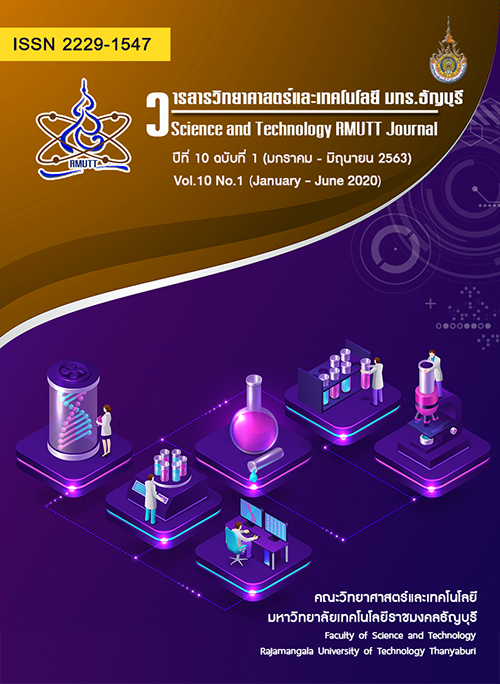Differences in nutrition Status and Academic Performance between Male and Female Undergraduate Food and Nutrition Students
Main Article Content
Abstract
This survey research aims to investigate the differences between nutritional status and academic performance between male and female undergraduate food and nutrition students. Two hundred and forty-six students were collected from the Department of Food and Nutrition, Faculty of Home Economics Technology, Rajamangala University of Technology Thanyaburi. Nutritional assessment was determined by body composition, body mass index (BMI), blood pressure, hemoglobin (HGB), blood vessel width (%), venous oxygenation index and finger surface temperature. Academic performance was recorded from the final examination results in two subjects including Diet Therapy and Human Nutrition. Data were analyzed by using descriptive statistics, independent-samples t-test, and Pearson's correlation analysis. The results showed that males had a significantly higher than females in height, body weight, body mass index, muscle mass, systolic blood pressure (SBP), hemoglobin and blood vessel width (%). Females had significantly higher than males in all the academic score. Hemoglobin was found to be correlated significantly with academic performance but weight and body mass index were found to be correlated significantly with only Human Nutrition. This study showed that females performed better academically than males and had body weight and body mass index lower than males in undergraduate food and nutrition students.
Article Details
References
World Health Organization (WHO) [Internet] Obesity and overweight. [updated 2018 Feb 16; cited 2019 Apr 29]. Available from: http://www.who.int/mediacentre/factsheets/fs311/en/.
W. Ekapakorn. (Editor). Report of the Thai Public Health Survey by the 5th Physical Examination 2014. Nonthaburi: Health Systems Research Institute (HSRI). 2014: 134.
WY. Gan, MT. Mohd Nasir, MS. Zalilah and A. Hazizi. Differences in Eating Behaviours, Dietary Intake and Body Weight Status between Male and Female Malaysian University Students. Mal J Nutr. 2011. 17(2): 213-218.
National Center for Chronic Disease Prevention and Health Promotion (CDD). Health and academic achievement. [cited 2019 Apr 29]. Available from: https://www.cdc.gov/healthyyouth/health_and_academics/pdf/health-academic-achievement.pdf.
P. Correa-Burrows, R. Burrows, E. Blanco, M. Reyesa and S. Gahaganb. Nutritional quality of diet and academic performance in Chilean students. Bull World Health Organ. 2016. 94: 185–192.
JJM. Hamid, KM. Amal, H. Hasmiza, CD. Pim, LO. Ng and MWM. Wan. Effect of Gender and Nutritional Status on Academic Achievement and Cognitive Function among Primary School Children in a Rural District in Malaysia. Mal J Nutr, 2011. 17(2): 189-200.
InBody CO., LTD. [Internet]. InBody720. [cited 2019 Apr 29]. Available from: https://inbody.com/eng/product/inbody720.aspx.
InBody CO., LTD. [Internet]. InBodyBSM370. [cited 2019 Apr 29]. Available from: http://inbody.com.hk/bsm370/.
World Health Organization (WHO). Appropriate body-mass index for Asian populations and its implications for policy and intervention strategies. THE LANCET. January 10, 2004: 363.
Y. Gallagher, SB. Heymsfield, M. Heo, SA. Jebb, PR. Murgatroyd and Y. Sakamoto. Healthy percentage body fat ranges: an approach for developing guidelines based on body mass index. Am J Clin Nutr. 2000. 72: 694-701.
Anonymous [Internet]. Results Interpretation & Application. [cited 2019 Apr 29]. Available from: https://www.bodyanalyse.no/gammel/images/stories/inbody/dokumenter/Inbody_720_Results_Interpretation.pdf.
Omron Healthcare Asia [Internet]. Omron HEM-8712. [cited 2019 Apr 29]. Available from: https://www.omronhealthcare-ap.-com/th/product/164-hem-8712/1.
N. Jeyanthi, BV. Gokulnath and R. Thandeeswaran. A complete survey on blood pressure monitoring devices and applications. Biomedical Research 2018. 29(21): 3751-3765.
Thai Hypertension Society, Thai Guidelines on The Treatment of Hypertension 2012 Update 2015. [cited 2019 Apr 29]. Available from: http://www.thaihypertension.org/files/GL%20HT%202015.pdf.
Sysmex Corporation [Internet]. ASTRIM FIT health monitoring analyzer. [cited 2019 Apr 29]. Available from: https://www.sysmex.co.jp/en/corporate/news/2014/140115.html.
World Health Organization (WHO) [Internet]. Haemoglobin concentrations for the diagnosis of anaemia and assessment of severity 2011. [cited 2019 Apr 29]. Available from: http://www.who.int/-vmnis/indicators/haemoglobin.pdf.
SPSS Inc. Released 2009. PASW Statistics for Windows. Version 18.0. Chicago: SPSS Inc.
N.H. Abdull Hakim, N.D. Muniandy and D. Ajau. Nutritonal Satus and Eating Practices among University Students in Selected Universities in Selangor, Malaysia. Asian Journal of Clinical Nutrition. 2012.
H. Nurul and A. Ruzita. Preliminary Survey on Nutritional Status among University Students at Malaysia. Pak. J. Nutr. 2010. 9(2): 125-127.
GG. Bogna, T. Andrzej, K. Natalia, P. Juliusz, SJ. Agnieszka and K. Elzbieta, Physical activity, nutritional status, and dietary habits of students of a medical university. Sport Sci Health. 2016. 12: 261–267.


